Corporate Finance: Riverlea Capital Budgeting and Market Impact Report
VerifiedAdded on 2020/03/23
|16
|3226
|37
Report
AI Summary
This report presents a comprehensive analysis of Riverlea's capital budgeting project. It begins with an executive summary highlighting the importance of capital budgeting in business management. The report then delves into the calculation of Net Present Value (NPV) under various scenarios, providing detailed tables and appendices to illustrate the step-by-step process of calculating initial costs, CFAT, and NPV. Furthermore, it examines the movement of the company's stock price following the announcement of the investment decision, relating the findings to the semi-strong market hypothesis. The report calculates the cost of equity using CAPM and analyzes initial costs and depreciation. The analysis shows the project's financial viability and recommends acceptance, considering both financial and non-financial factors. The report concludes that the investment has a positive effect on the stock price and recommends that the management should consider the fact that the stock price depends on lots of factors some of which are beyond the control of the firm.

Running Head: Corporate Finance
Student Name:
Corporate Finance
Institute Name:
Affiliation:
Student Name:
Corporate Finance
Institute Name:
Affiliation:
Paraphrase This Document
Need a fresh take? Get an instant paraphrase of this document with our AI Paraphraser
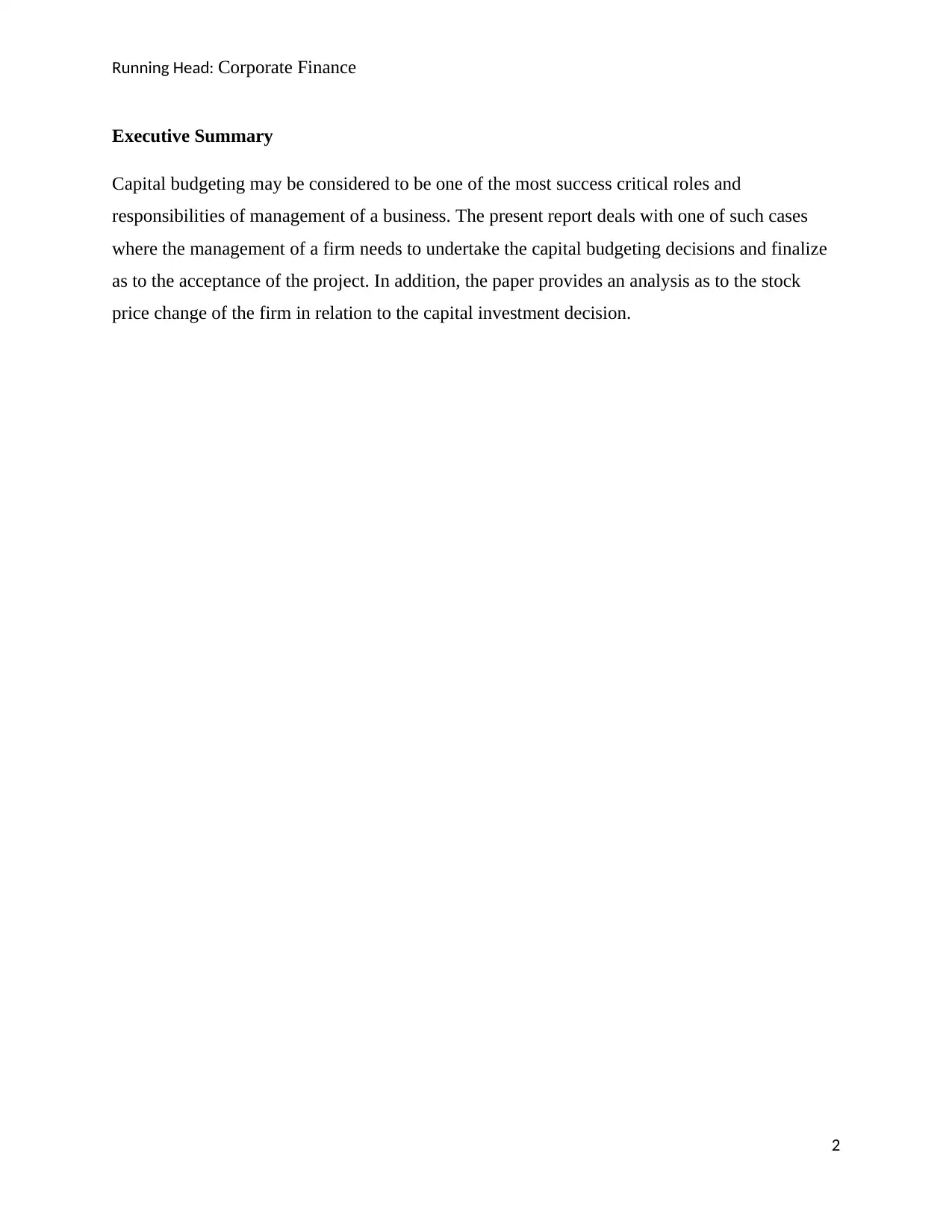
Running Head: Corporate Finance
Executive Summary
Capital budgeting may be considered to be one of the most success critical roles and
responsibilities of management of a business. The present report deals with one of such cases
where the management of a firm needs to undertake the capital budgeting decisions and finalize
as to the acceptance of the project. In addition, the paper provides an analysis as to the stock
price change of the firm in relation to the capital investment decision.
2
Executive Summary
Capital budgeting may be considered to be one of the most success critical roles and
responsibilities of management of a business. The present report deals with one of such cases
where the management of a firm needs to undertake the capital budgeting decisions and finalize
as to the acceptance of the project. In addition, the paper provides an analysis as to the stock
price change of the firm in relation to the capital investment decision.
2
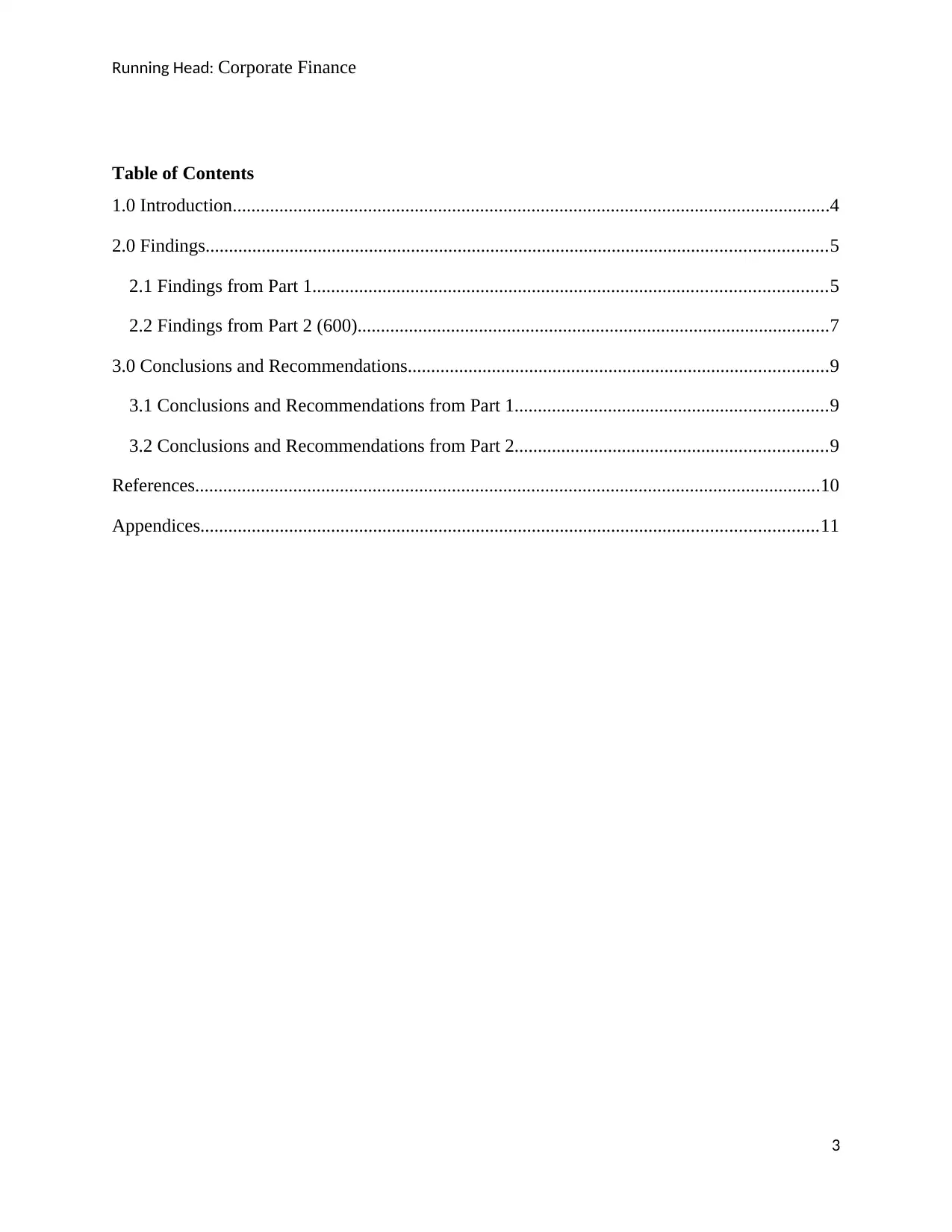
Running Head: Corporate Finance
Table of Contents
1.0 Introduction................................................................................................................................4
2.0 Findings.....................................................................................................................................5
2.1 Findings from Part 1..............................................................................................................5
2.2 Findings from Part 2 (600).....................................................................................................7
3.0 Conclusions and Recommendations..........................................................................................9
3.1 Conclusions and Recommendations from Part 1...................................................................9
3.2 Conclusions and Recommendations from Part 2...................................................................9
References......................................................................................................................................10
Appendices....................................................................................................................................11
3
Table of Contents
1.0 Introduction................................................................................................................................4
2.0 Findings.....................................................................................................................................5
2.1 Findings from Part 1..............................................................................................................5
2.2 Findings from Part 2 (600).....................................................................................................7
3.0 Conclusions and Recommendations..........................................................................................9
3.1 Conclusions and Recommendations from Part 1...................................................................9
3.2 Conclusions and Recommendations from Part 2...................................................................9
References......................................................................................................................................10
Appendices....................................................................................................................................11
3
⊘ This is a preview!⊘
Do you want full access?
Subscribe today to unlock all pages.

Trusted by 1+ million students worldwide
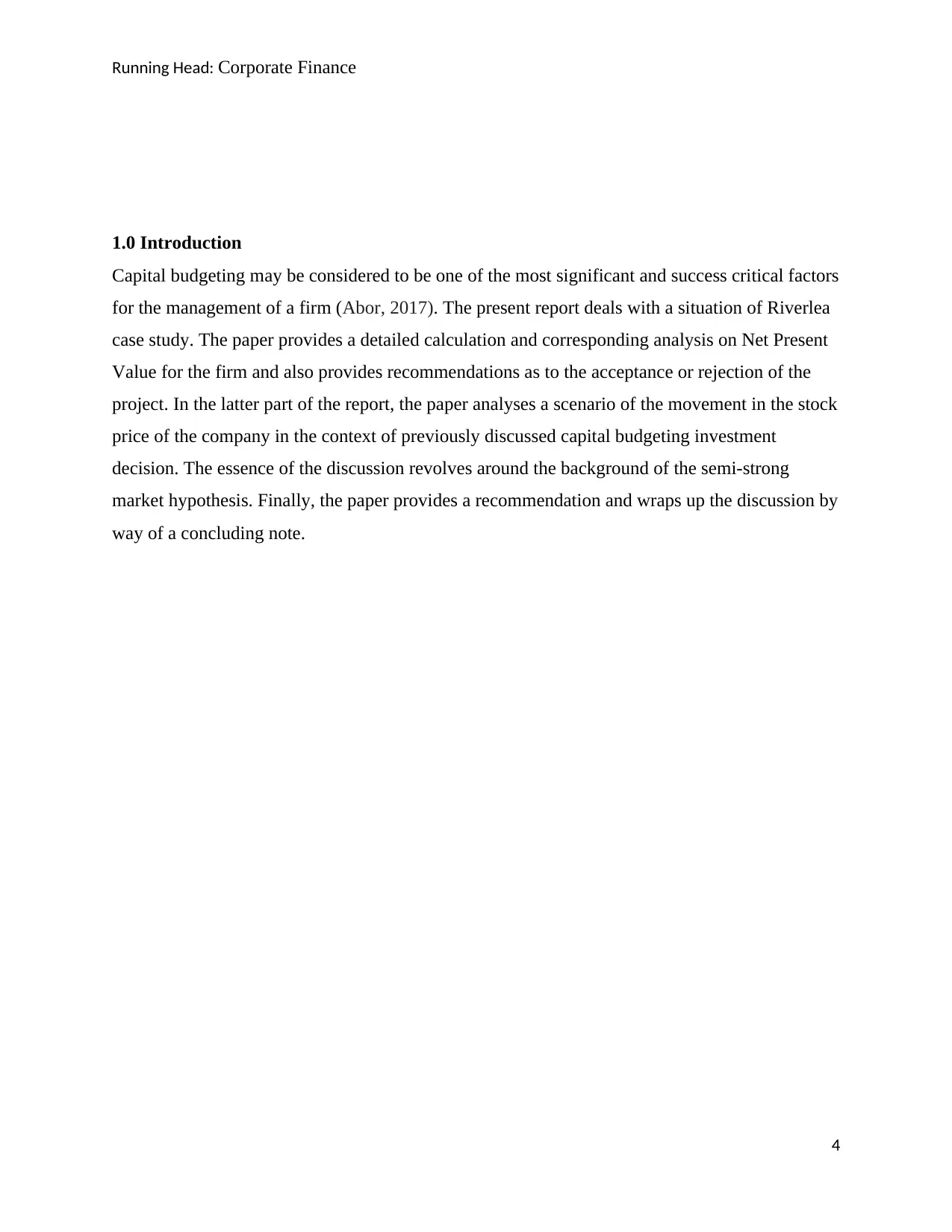
Running Head: Corporate Finance
1.0 Introduction
Capital budgeting may be considered to be one of the most significant and success critical factors
for the management of a firm (Abor, 2017). The present report deals with a situation of Riverlea
case study. The paper provides a detailed calculation and corresponding analysis on Net Present
Value for the firm and also provides recommendations as to the acceptance or rejection of the
project. In the latter part of the report, the paper analyses a scenario of the movement in the stock
price of the company in the context of previously discussed capital budgeting investment
decision. The essence of the discussion revolves around the background of the semi-strong
market hypothesis. Finally, the paper provides a recommendation and wraps up the discussion by
way of a concluding note.
4
1.0 Introduction
Capital budgeting may be considered to be one of the most significant and success critical factors
for the management of a firm (Abor, 2017). The present report deals with a situation of Riverlea
case study. The paper provides a detailed calculation and corresponding analysis on Net Present
Value for the firm and also provides recommendations as to the acceptance or rejection of the
project. In the latter part of the report, the paper analyses a scenario of the movement in the stock
price of the company in the context of previously discussed capital budgeting investment
decision. The essence of the discussion revolves around the background of the semi-strong
market hypothesis. Finally, the paper provides a recommendation and wraps up the discussion by
way of a concluding note.
4
Paraphrase This Document
Need a fresh take? Get an instant paraphrase of this document with our AI Paraphraser
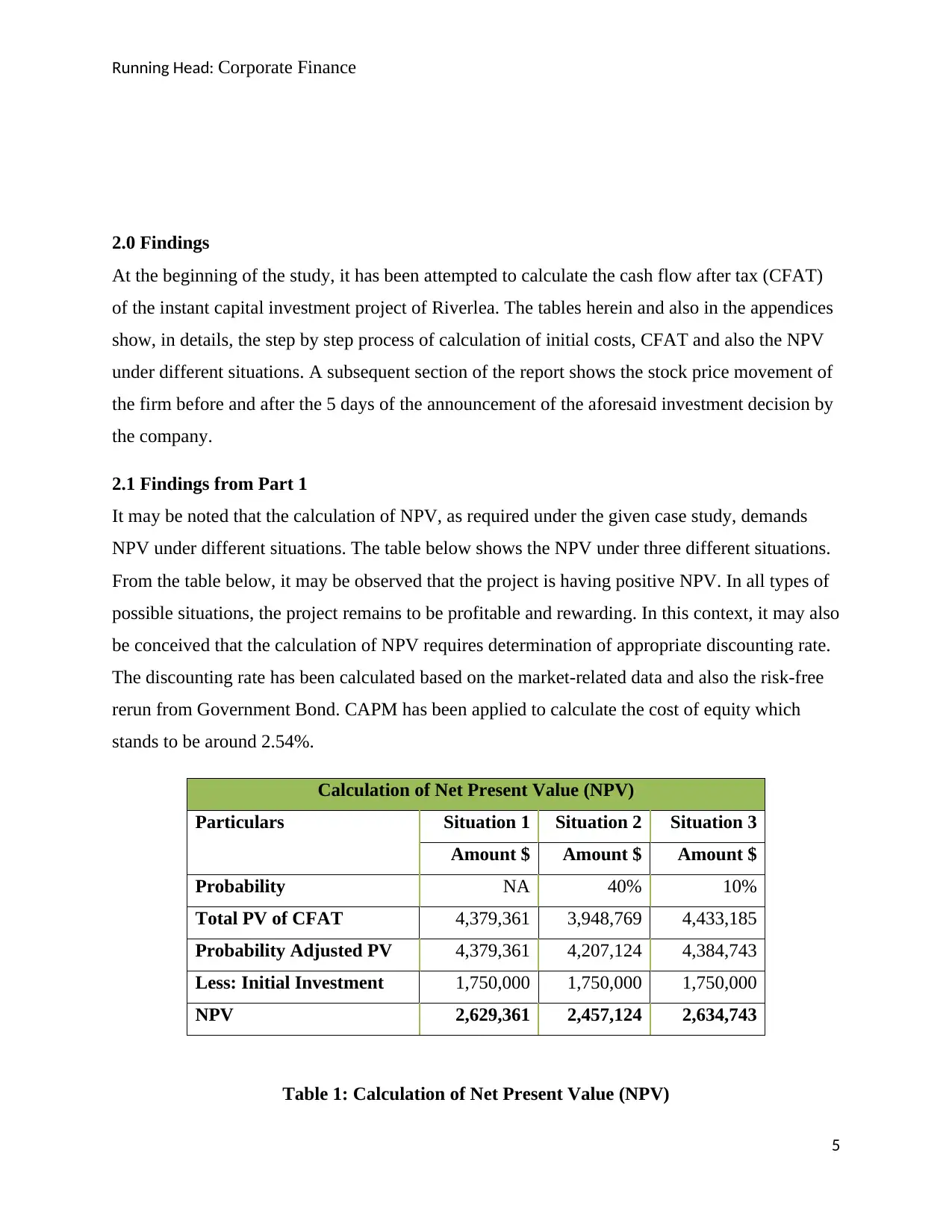
Running Head: Corporate Finance
2.0 Findings
At the beginning of the study, it has been attempted to calculate the cash flow after tax (CFAT)
of the instant capital investment project of Riverlea. The tables herein and also in the appendices
show, in details, the step by step process of calculation of initial costs, CFAT and also the NPV
under different situations. A subsequent section of the report shows the stock price movement of
the firm before and after the 5 days of the announcement of the aforesaid investment decision by
the company.
2.1 Findings from Part 1
It may be noted that the calculation of NPV, as required under the given case study, demands
NPV under different situations. The table below shows the NPV under three different situations.
From the table below, it may be observed that the project is having positive NPV. In all types of
possible situations, the project remains to be profitable and rewarding. In this context, it may also
be conceived that the calculation of NPV requires determination of appropriate discounting rate.
The discounting rate has been calculated based on the market-related data and also the risk-free
rerun from Government Bond. CAPM has been applied to calculate the cost of equity which
stands to be around 2.54%.
Calculation of Net Present Value (NPV)
Particulars Situation 1 Situation 2 Situation 3
Amount $ Amount $ Amount $
Probability NA 40% 10%
Total PV of CFAT 4,379,361 3,948,769 4,433,185
Probability Adjusted PV 4,379,361 4,207,124 4,384,743
Less: Initial Investment 1,750,000 1,750,000 1,750,000
NPV 2,629,361 2,457,124 2,634,743
Table 1: Calculation of Net Present Value (NPV)
5
2.0 Findings
At the beginning of the study, it has been attempted to calculate the cash flow after tax (CFAT)
of the instant capital investment project of Riverlea. The tables herein and also in the appendices
show, in details, the step by step process of calculation of initial costs, CFAT and also the NPV
under different situations. A subsequent section of the report shows the stock price movement of
the firm before and after the 5 days of the announcement of the aforesaid investment decision by
the company.
2.1 Findings from Part 1
It may be noted that the calculation of NPV, as required under the given case study, demands
NPV under different situations. The table below shows the NPV under three different situations.
From the table below, it may be observed that the project is having positive NPV. In all types of
possible situations, the project remains to be profitable and rewarding. In this context, it may also
be conceived that the calculation of NPV requires determination of appropriate discounting rate.
The discounting rate has been calculated based on the market-related data and also the risk-free
rerun from Government Bond. CAPM has been applied to calculate the cost of equity which
stands to be around 2.54%.
Calculation of Net Present Value (NPV)
Particulars Situation 1 Situation 2 Situation 3
Amount $ Amount $ Amount $
Probability NA 40% 10%
Total PV of CFAT 4,379,361 3,948,769 4,433,185
Probability Adjusted PV 4,379,361 4,207,124 4,384,743
Less: Initial Investment 1,750,000 1,750,000 1,750,000
NPV 2,629,361 2,457,124 2,634,743
Table 1: Calculation of Net Present Value (NPV)
5
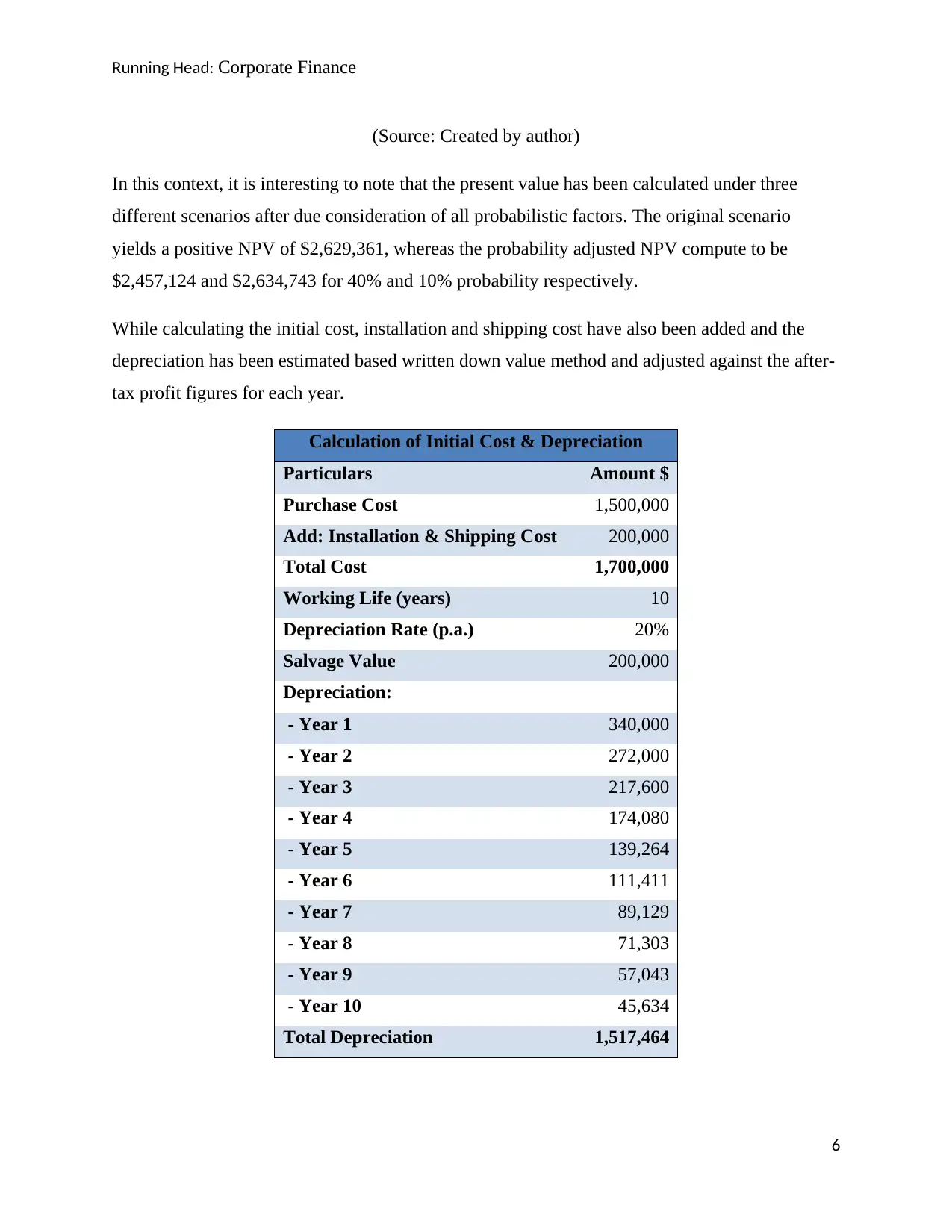
Running Head: Corporate Finance
(Source: Created by author)
In this context, it is interesting to note that the present value has been calculated under three
different scenarios after due consideration of all probabilistic factors. The original scenario
yields a positive NPV of $2,629,361, whereas the probability adjusted NPV compute to be
$2,457,124 and $2,634,743 for 40% and 10% probability respectively.
While calculating the initial cost, installation and shipping cost have also been added and the
depreciation has been estimated based written down value method and adjusted against the after-
tax profit figures for each year.
Calculation of Initial Cost & Depreciation
Particulars Amount $
Purchase Cost 1,500,000
Add: Installation & Shipping Cost 200,000
Total Cost 1,700,000
Working Life (years) 10
Depreciation Rate (p.a.) 20%
Salvage Value 200,000
Depreciation:
- Year 1 340,000
- Year 2 272,000
- Year 3 217,600
- Year 4 174,080
- Year 5 139,264
- Year 6 111,411
- Year 7 89,129
- Year 8 71,303
- Year 9 57,043
- Year 10 45,634
Total Depreciation 1,517,464
6
(Source: Created by author)
In this context, it is interesting to note that the present value has been calculated under three
different scenarios after due consideration of all probabilistic factors. The original scenario
yields a positive NPV of $2,629,361, whereas the probability adjusted NPV compute to be
$2,457,124 and $2,634,743 for 40% and 10% probability respectively.
While calculating the initial cost, installation and shipping cost have also been added and the
depreciation has been estimated based written down value method and adjusted against the after-
tax profit figures for each year.
Calculation of Initial Cost & Depreciation
Particulars Amount $
Purchase Cost 1,500,000
Add: Installation & Shipping Cost 200,000
Total Cost 1,700,000
Working Life (years) 10
Depreciation Rate (p.a.) 20%
Salvage Value 200,000
Depreciation:
- Year 1 340,000
- Year 2 272,000
- Year 3 217,600
- Year 4 174,080
- Year 5 139,264
- Year 6 111,411
- Year 7 89,129
- Year 8 71,303
- Year 9 57,043
- Year 10 45,634
Total Depreciation 1,517,464
6
⊘ This is a preview!⊘
Do you want full access?
Subscribe today to unlock all pages.

Trusted by 1+ million students worldwide
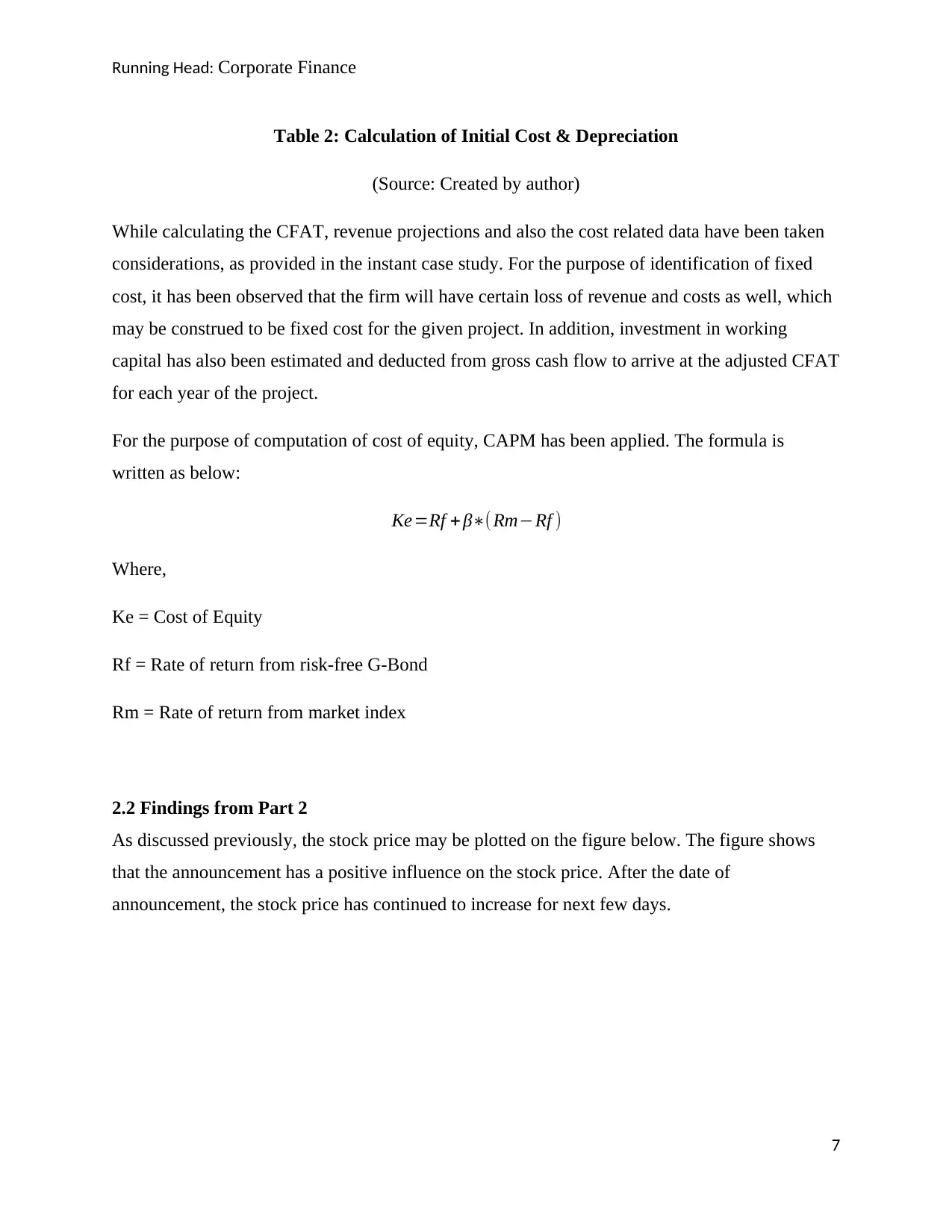
Running Head: Corporate Finance
Table 2: Calculation of Initial Cost & Depreciation
(Source: Created by author)
While calculating the CFAT, revenue projections and also the cost related data have been taken
considerations, as provided in the instant case study. For the purpose of identification of fixed
cost, it has been observed that the firm will have certain loss of revenue and costs as well, which
may be construed to be fixed cost for the given project. In addition, investment in working
capital has also been estimated and deducted from gross cash flow to arrive at the adjusted CFAT
for each year of the project.
For the purpose of computation of cost of equity, CAPM has been applied. The formula is
written as below:
Ke=Rf + β∗( Rm−Rf )
Where,
Ke = Cost of Equity
Rf = Rate of return from risk-free G-Bond
Rm = Rate of return from market index
2.2 Findings from Part 2
As discussed previously, the stock price may be plotted on the figure below. The figure shows
that the announcement has a positive influence on the stock price. After the date of
announcement, the stock price has continued to increase for next few days.
7
Table 2: Calculation of Initial Cost & Depreciation
(Source: Created by author)
While calculating the CFAT, revenue projections and also the cost related data have been taken
considerations, as provided in the instant case study. For the purpose of identification of fixed
cost, it has been observed that the firm will have certain loss of revenue and costs as well, which
may be construed to be fixed cost for the given project. In addition, investment in working
capital has also been estimated and deducted from gross cash flow to arrive at the adjusted CFAT
for each year of the project.
For the purpose of computation of cost of equity, CAPM has been applied. The formula is
written as below:
Ke=Rf + β∗( Rm−Rf )
Where,
Ke = Cost of Equity
Rf = Rate of return from risk-free G-Bond
Rm = Rate of return from market index
2.2 Findings from Part 2
As discussed previously, the stock price may be plotted on the figure below. The figure shows
that the announcement has a positive influence on the stock price. After the date of
announcement, the stock price has continued to increase for next few days.
7
Paraphrase This Document
Need a fresh take? Get an instant paraphrase of this document with our AI Paraphraser
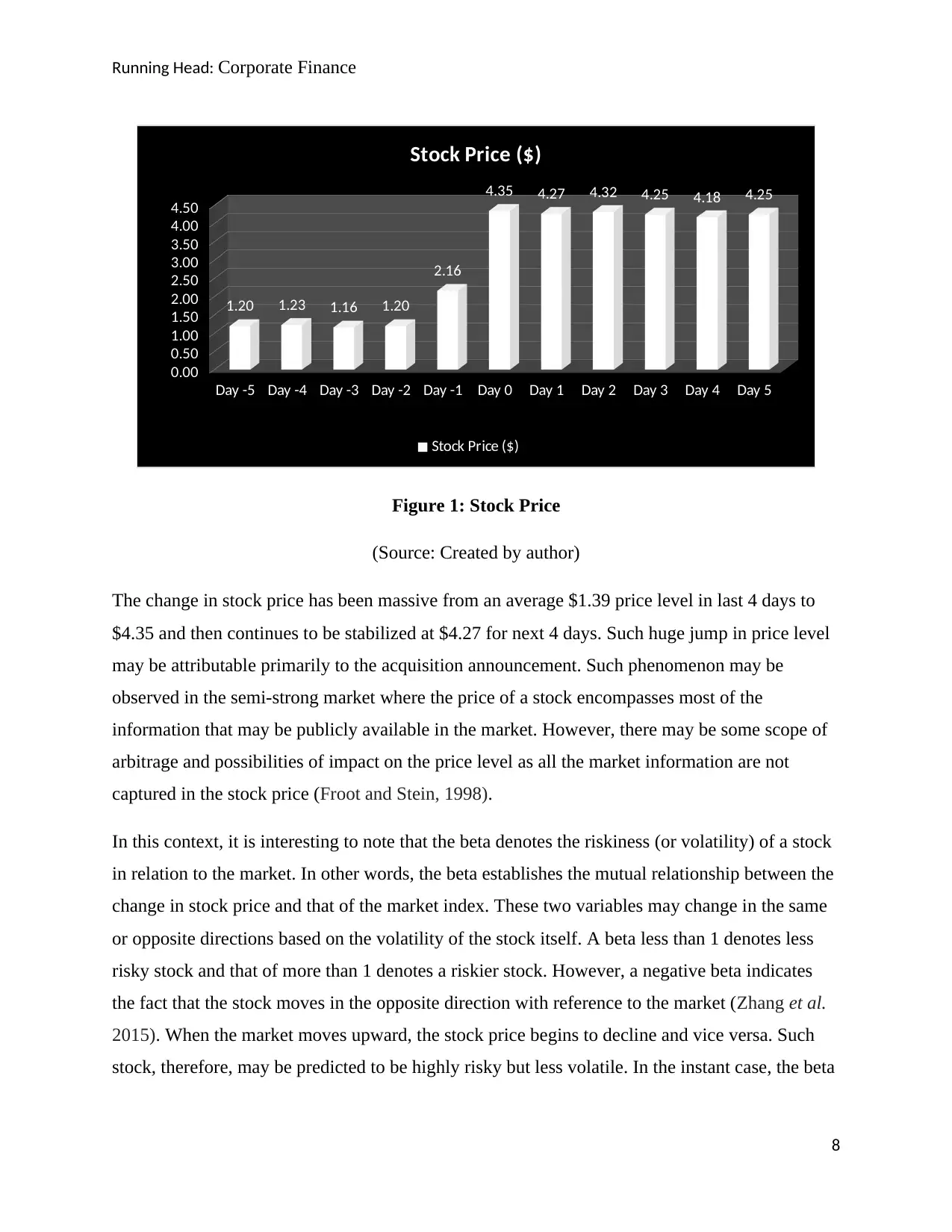
Running Head: Corporate Finance
Day -5 Day -4 Day -3 Day -2 Day -1 Day 0 Day 1 Day 2 Day 3 Day 4 Day 5
0.00
0.50
1.00
1.50
2.00
2.50
3.00
3.50
4.00
4.50
1.20 1.23 1.16 1.20
2.16
4.35 4.27 4.32 4.25 4.18 4.25
Stock Price ($)
Stock Price ($)
Figure 1: Stock Price
(Source: Created by author)
The change in stock price has been massive from an average $1.39 price level in last 4 days to
$4.35 and then continues to be stabilized at $4.27 for next 4 days. Such huge jump in price level
may be attributable primarily to the acquisition announcement. Such phenomenon may be
observed in the semi-strong market where the price of a stock encompasses most of the
information that may be publicly available in the market. However, there may be some scope of
arbitrage and possibilities of impact on the price level as all the market information are not
captured in the stock price (Froot and Stein, 1998).
In this context, it is interesting to note that the beta denotes the riskiness (or volatility) of a stock
in relation to the market. In other words, the beta establishes the mutual relationship between the
change in stock price and that of the market index. These two variables may change in the same
or opposite directions based on the volatility of the stock itself. A beta less than 1 denotes less
risky stock and that of more than 1 denotes a riskier stock. However, a negative beta indicates
the fact that the stock moves in the opposite direction with reference to the market (Zhang et al.
2015). When the market moves upward, the stock price begins to decline and vice versa. Such
stock, therefore, may be predicted to be highly risky but less volatile. In the instant case, the beta
8
Day -5 Day -4 Day -3 Day -2 Day -1 Day 0 Day 1 Day 2 Day 3 Day 4 Day 5
0.00
0.50
1.00
1.50
2.00
2.50
3.00
3.50
4.00
4.50
1.20 1.23 1.16 1.20
2.16
4.35 4.27 4.32 4.25 4.18 4.25
Stock Price ($)
Stock Price ($)
Figure 1: Stock Price
(Source: Created by author)
The change in stock price has been massive from an average $1.39 price level in last 4 days to
$4.35 and then continues to be stabilized at $4.27 for next 4 days. Such huge jump in price level
may be attributable primarily to the acquisition announcement. Such phenomenon may be
observed in the semi-strong market where the price of a stock encompasses most of the
information that may be publicly available in the market. However, there may be some scope of
arbitrage and possibilities of impact on the price level as all the market information are not
captured in the stock price (Froot and Stein, 1998).
In this context, it is interesting to note that the beta denotes the riskiness (or volatility) of a stock
in relation to the market. In other words, the beta establishes the mutual relationship between the
change in stock price and that of the market index. These two variables may change in the same
or opposite directions based on the volatility of the stock itself. A beta less than 1 denotes less
risky stock and that of more than 1 denotes a riskier stock. However, a negative beta indicates
the fact that the stock moves in the opposite direction with reference to the market (Zhang et al.
2015). When the market moves upward, the stock price begins to decline and vice versa. Such
stock, therefore, may be predicted to be highly risky but less volatile. In the instant case, the beta
8

Running Head: Corporate Finance
is computed to be -0.56 which signifies that the stock price will change in the opposite direction
with that of the market index.
9
is computed to be -0.56 which signifies that the stock price will change in the opposite direction
with that of the market index.
9
⊘ This is a preview!⊘
Do you want full access?
Subscribe today to unlock all pages.

Trusted by 1+ million students worldwide
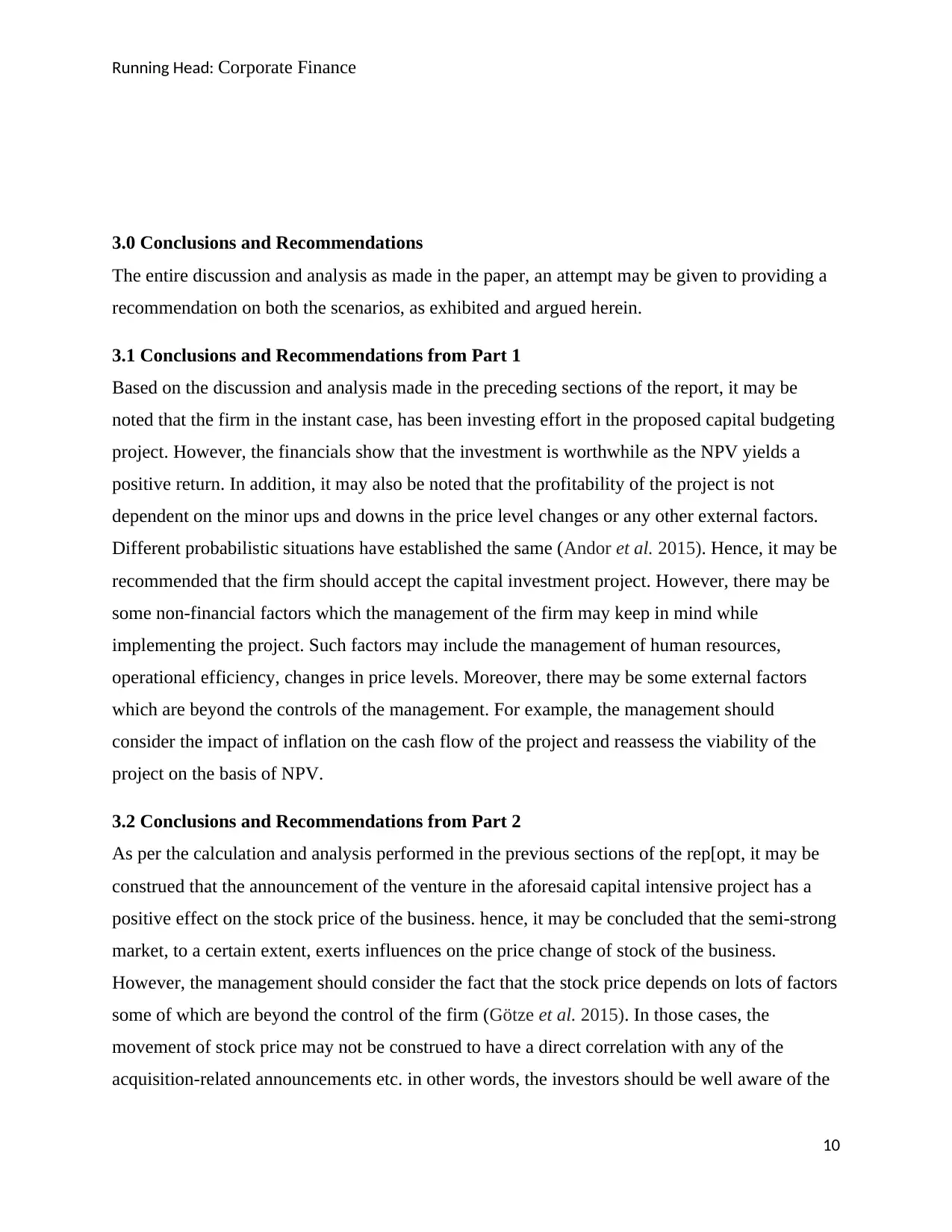
Running Head: Corporate Finance
3.0 Conclusions and Recommendations
The entire discussion and analysis as made in the paper, an attempt may be given to providing a
recommendation on both the scenarios, as exhibited and argued herein.
3.1 Conclusions and Recommendations from Part 1
Based on the discussion and analysis made in the preceding sections of the report, it may be
noted that the firm in the instant case, has been investing effort in the proposed capital budgeting
project. However, the financials show that the investment is worthwhile as the NPV yields a
positive return. In addition, it may also be noted that the profitability of the project is not
dependent on the minor ups and downs in the price level changes or any other external factors.
Different probabilistic situations have established the same (Andor et al. 2015). Hence, it may be
recommended that the firm should accept the capital investment project. However, there may be
some non-financial factors which the management of the firm may keep in mind while
implementing the project. Such factors may include the management of human resources,
operational efficiency, changes in price levels. Moreover, there may be some external factors
which are beyond the controls of the management. For example, the management should
consider the impact of inflation on the cash flow of the project and reassess the viability of the
project on the basis of NPV.
3.2 Conclusions and Recommendations from Part 2
As per the calculation and analysis performed in the previous sections of the rep[opt, it may be
construed that the announcement of the venture in the aforesaid capital intensive project has a
positive effect on the stock price of the business. hence, it may be concluded that the semi-strong
market, to a certain extent, exerts influences on the price change of stock of the business.
However, the management should consider the fact that the stock price depends on lots of factors
some of which are beyond the control of the firm (Götze et al. 2015). In those cases, the
movement of stock price may not be construed to have a direct correlation with any of the
acquisition-related announcements etc. in other words, the investors should be well aware of the
10
3.0 Conclusions and Recommendations
The entire discussion and analysis as made in the paper, an attempt may be given to providing a
recommendation on both the scenarios, as exhibited and argued herein.
3.1 Conclusions and Recommendations from Part 1
Based on the discussion and analysis made in the preceding sections of the report, it may be
noted that the firm in the instant case, has been investing effort in the proposed capital budgeting
project. However, the financials show that the investment is worthwhile as the NPV yields a
positive return. In addition, it may also be noted that the profitability of the project is not
dependent on the minor ups and downs in the price level changes or any other external factors.
Different probabilistic situations have established the same (Andor et al. 2015). Hence, it may be
recommended that the firm should accept the capital investment project. However, there may be
some non-financial factors which the management of the firm may keep in mind while
implementing the project. Such factors may include the management of human resources,
operational efficiency, changes in price levels. Moreover, there may be some external factors
which are beyond the controls of the management. For example, the management should
consider the impact of inflation on the cash flow of the project and reassess the viability of the
project on the basis of NPV.
3.2 Conclusions and Recommendations from Part 2
As per the calculation and analysis performed in the previous sections of the rep[opt, it may be
construed that the announcement of the venture in the aforesaid capital intensive project has a
positive effect on the stock price of the business. hence, it may be concluded that the semi-strong
market, to a certain extent, exerts influences on the price change of stock of the business.
However, the management should consider the fact that the stock price depends on lots of factors
some of which are beyond the control of the firm (Götze et al. 2015). In those cases, the
movement of stock price may not be construed to have a direct correlation with any of the
acquisition-related announcements etc. in other words, the investors should be well aware of the
10
Paraphrase This Document
Need a fresh take? Get an instant paraphrase of this document with our AI Paraphraser

Running Head: Corporate Finance
fact that the stock price in the market may not be synonymous with the financial performance of
the business. There are certain correlations between the business performance and stock price, it
may be noted that the stock price should be judiciously assessed by both the investors and the
management to identify the reasons for such movement.
11
fact that the stock price in the market may not be synonymous with the financial performance of
the business. There are certain correlations between the business performance and stock price, it
may be noted that the stock price should be judiciously assessed by both the investors and the
management to identify the reasons for such movement.
11
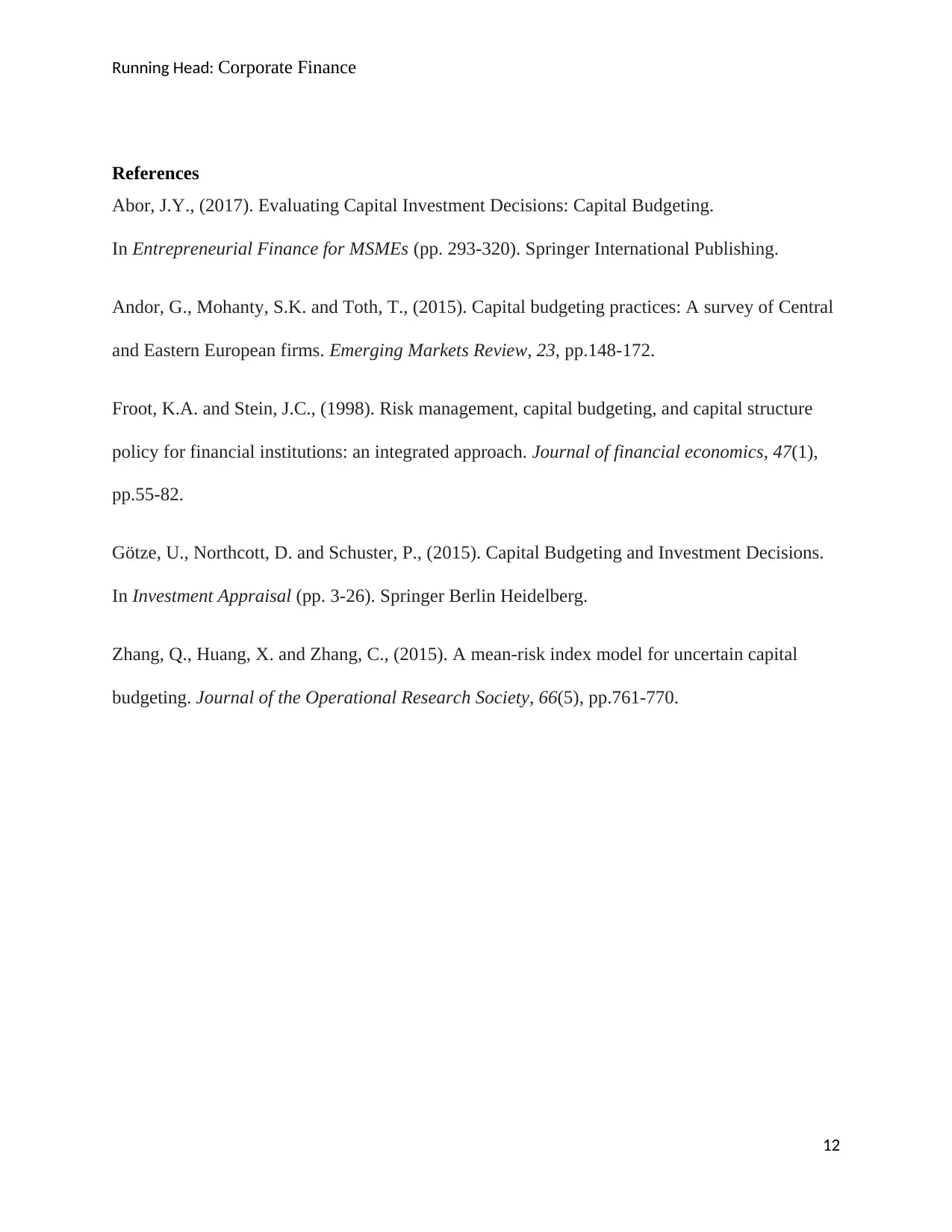
Running Head: Corporate Finance
References
Abor, J.Y., (2017). Evaluating Capital Investment Decisions: Capital Budgeting.
In Entrepreneurial Finance for MSMEs (pp. 293-320). Springer International Publishing.
Andor, G., Mohanty, S.K. and Toth, T., (2015). Capital budgeting practices: A survey of Central
and Eastern European firms. Emerging Markets Review, 23, pp.148-172.
Froot, K.A. and Stein, J.C., (1998). Risk management, capital budgeting, and capital structure
policy for financial institutions: an integrated approach. Journal of financial economics, 47(1),
pp.55-82.
Götze, U., Northcott, D. and Schuster, P., (2015). Capital Budgeting and Investment Decisions.
In Investment Appraisal (pp. 3-26). Springer Berlin Heidelberg.
Zhang, Q., Huang, X. and Zhang, C., (2015). A mean-risk index model for uncertain capital
budgeting. Journal of the Operational Research Society, 66(5), pp.761-770.
12
References
Abor, J.Y., (2017). Evaluating Capital Investment Decisions: Capital Budgeting.
In Entrepreneurial Finance for MSMEs (pp. 293-320). Springer International Publishing.
Andor, G., Mohanty, S.K. and Toth, T., (2015). Capital budgeting practices: A survey of Central
and Eastern European firms. Emerging Markets Review, 23, pp.148-172.
Froot, K.A. and Stein, J.C., (1998). Risk management, capital budgeting, and capital structure
policy for financial institutions: an integrated approach. Journal of financial economics, 47(1),
pp.55-82.
Götze, U., Northcott, D. and Schuster, P., (2015). Capital Budgeting and Investment Decisions.
In Investment Appraisal (pp. 3-26). Springer Berlin Heidelberg.
Zhang, Q., Huang, X. and Zhang, C., (2015). A mean-risk index model for uncertain capital
budgeting. Journal of the Operational Research Society, 66(5), pp.761-770.
12
⊘ This is a preview!⊘
Do you want full access?
Subscribe today to unlock all pages.

Trusted by 1+ million students worldwide
1 out of 16
Related Documents
Your All-in-One AI-Powered Toolkit for Academic Success.
+13062052269
info@desklib.com
Available 24*7 on WhatsApp / Email
![[object Object]](/_next/static/media/star-bottom.7253800d.svg)
Unlock your academic potential
Copyright © 2020–2025 A2Z Services. All Rights Reserved. Developed and managed by ZUCOL.





